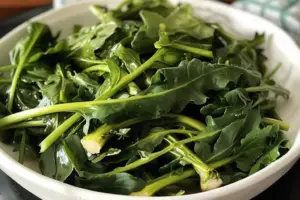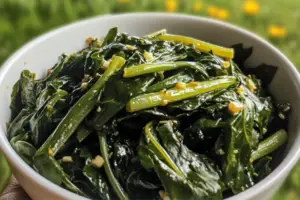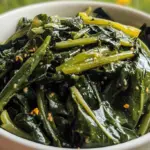Introduction
Dandelion greens, often dismissed as common lawn weeds, are actually nutritional powerhouses and culinary treasures hiding in plain sight. This Dandelion Greens with Garlic recipe transforms these humble wild greens into a sophisticated side dish that delivers extraordinary health benefits alongside delightful flavors. Dating back centuries across Mediterranean and European cuisines, dandelion greens have nourished generations with their exceptional vitamin and mineral content.
Spring is the perfect season to harvest or purchase dandelion greens when they’re at their tenderest and least bitter. This simple preparation highlights their unique earthy character while taming their natural bitterness through careful cooking techniques and complementary ingredients. The robust garlic, fruity olive oil, bright lemon, and optional red pepper flakes create a perfect balance that makes these nutrient-dense greens absolutely irresistible.
Whether you’re a foraging enthusiast, health-conscious cook, or culinary adventurer looking to expand your vegetable repertoire, this dandelion greens recipe offers an accessible entry point into the world of wild edibles. The dish works beautifully as a side for Mediterranean-inspired meals, pairs wonderfully with grilled proteins, or can be incorporated into pasta dishes for added nutrition and complexity.
In this comprehensive guide, I’ll walk you through selecting the perfect dandelion greens, proper cleaning techniques, and the step-by-step cooking process that transforms these overlooked greens into a delicious dish you’ll make again and again. You’ll also discover variations to customize the recipe to your taste preferences, along with valuable tips for reducing bitterness and enhancing flavor. Let’s dive into this nutritional powerhouse that connects us to seasonal eating and traditional food wisdom!
Ingredients

For the Basic Recipe (Serves 4 as a side dish):
- 2 pounds (about 900g) fresh dandelion greens, preferably young spring greens
- 4 tablespoons extra virgin olive oil
- 6 cloves garlic, thinly sliced (about 2 tablespoons)
- ¼ teaspoon red pepper flakes (optional, adjust to taste)
- 1 teaspoon sea salt, divided
- ½ teaspoon freshly ground black pepper
- 1 tablespoon fresh lemon juice
- Lemon wedges for serving
Optional Ingredients for Enhanced Flavor:
- 2 tablespoons pine nuts or sliced almonds
- 2 tablespoons golden raisins (pre-soaked in warm water)
- 1 tablespoon capers, rinsed and drained
- 1 anchovy fillet, minced (for depth of flavor, dissolves completely)
- 2 tablespoons freshly grated Parmesan or Pecorino Romano cheese
- 1 small shallot, minced
- 1 teaspoon lemon zest
- 1 teaspoon honey or maple syrup (to balance bitterness)
- 2 tablespoons white wine or vegetable broth
Preparation
Step 1: Select and Clean the Dandelion Greens
Start by examining your dandelion greens carefully. If you’ve harvested them yourself, select young, tender leaves before the plants flower for the mildest flavor. Store-bought dandelion greens should have vibrant green leaves without signs of wilting or yellowing.
Fill a large bowl or clean sink with cold water and add 1 tablespoon of salt. Submerge the dandelion greens completely and swish them around gently to dislodge any dirt, grit, or small insects. Let them soak for 5-10 minutes – this salt bath also helps reduce bitterness. Lift the greens from the water (rather than pouring them into a colander, which would reintroduce the dirt), leaving any grit behind. Repeat this washing process 2-3 times until no sand or dirt remains at the bottom of the bowl.
Once clean, thoroughly pat the greens dry using kitchen towels or a salad spinner. Excessive moisture will cause splattering when the greens hit the hot oil and can make them steam rather than sauté properly.
Step 2: Prepare the Dandelion Greens
Trim any tough stems, especially from the bottom of the bunch where they can be particularly fibrous. For larger leaves, you may want to separate the leafy parts from the center ribs if they seem particularly thick. Stack several leaves together at a time and cut them crosswise into 2-inch sections for easier cooking and eating. Set aside while you prepare the pan.
Step 3: Prepare the Garlic and Pan
Place a large, heavy-bottomed skillet (preferably cast iron or stainless steel) over medium-low heat. Add the olive oil and allow it to warm gently. Add the thinly sliced garlic to the cold oil as it warms up – this method slowly infuses the oil with garlic flavor without burning it. Cook the garlic for 1-2 minutes until it becomes fragrant and just starts to turn golden around the edges. Be vigilant as garlic can quickly go from perfectly golden to burnt and bitter.
If using, add the red pepper flakes to the oil at this point and stir for about 15 seconds to release their heat and flavor into the oil.
Step 4: Sauté the Dandelion Greens
Working in batches if necessary (overcrowding will cause the greens to steam rather than properly sauté), add the prepared dandelion greens to the pan. Use tongs to turn and coat the greens in the garlic-infused oil. Sprinkle with half the salt (½ teaspoon) and continue turning the greens as they begin to wilt.
Sauté the greens for about 5-7 minutes, turning frequently, until they are completely wilted but still maintain a bright green color. The cooking time will depend on the age and thickness of your greens – younger greens cook faster than mature ones. You want them tender but not mushy, with a slight bite remaining.
Step 5: Finish and Season
Once the greens have reached the desired tenderness, remove the pan from heat. Add the fresh lemon juice, remaining salt, and black pepper. Toss everything together to ensure even distribution of flavors. Taste and adjust seasonings as needed – you may want more salt, pepper, or lemon juice depending on the natural bitterness of your greens.
If using any optional ingredients like pine nuts, capers, or cheese, fold them in now. For pine nuts or almonds, you may want to lightly toast them in a dry pan before adding for enhanced flavor.
Transfer the finished dandelion greens to a serving platter and drizzle with a bit more extra virgin olive oil. Garnish with lemon wedges on the side for diners to add extra brightness as desired.
Variations

Mediterranean Variation
Add 2 tablespoons each of toasted pine nuts and golden raisins (soaked in warm water and drained) to the greens during the final minute of cooking. Top with 2 tablespoons of crumbled feta cheese and a sprinkle of fresh oregano leaves before serving.
Italian-Style Dandelion Greens
Incorporate 1 minced anchovy fillet when sautéing the garlic (it will dissolve completely). After cooking, top with 2 tablespoons of freshly grated Parmesan cheese and a drizzle of high-quality balsamic vinegar.
Asian-Inspired Dandelion Greens
Replace the olive oil with sesame oil, add 1 tablespoon of minced fresh ginger along with the garlic, and substitute rice vinegar for the lemon juice. Finish with a drizzle of soy sauce, a sprinkle of toasted sesame seeds, and sliced scallions.
Hearty Main Course Version
Transform this side dish into a main course by adding cannellini beans (one 15-oz can, drained and rinsed) during the last few minutes of cooking. Top with a poached or fried egg and serve with crusty bread for a complete protein-rich meal.
Sweet and Sour Dandelion Greens
Add 1 tablespoon honey or maple syrup and 2 tablespoons apple cider vinegar to balance the bitterness. Include ¼ cup diced dried apricots or cranberries for sweet bursts of flavor.
Spicy Southern-Style Greens
Add ¼ teaspoon smoked paprika and ⅛ teaspoon cayenne pepper along with the red pepper flakes. For deeper flavor, include 2 tablespoons of finely diced bacon or pancetta, cooked until crisp before adding the garlic.
Cooking Notes
Understanding Bitterness: Dandelion greens are naturally bitter, especially older leaves and those harvested after the plant has flowered. This bitterness is part of their appeal but can be modulated through proper selection and cooking. Young spring greens will always be less bitter than summer or fall harvests.
Blanching Option: For particularly bitter greens, consider blanching them before sautéing. Bring a large pot of heavily salted water to a boil, add the cleaned greens, and cook for 1-2 minutes. Immediately transfer to an ice bath to stop cooking, then squeeze out excess moisture before proceeding with the sauté step. This will remove some bitterness but also some nutrients.
Oil Quality Matters: Since this is a simple dish with few ingredients, the quality of your olive oil will significantly impact the final flavor. Use a good-quality extra virgin olive oil with a robust, fruity profile.
Cooking Temperature Control: Avoid high heat when cooking both the garlic and the greens. Garlic becomes bitter when burnt, and dandelion greens can turn unpleasantly bitter and lose their vibrant color if cooked too aggressively.
Storage Notes: This dish is best enjoyed fresh, but leftovers can be refrigerated for up to 2 days. The greens will maintain their flavor but will soften further. Rejuvenate leftovers with a fresh squeeze of lemon and a drizzle of olive oil before serving.
Serving Suggestions
Classic Pairings: Dandelion greens with garlic pair beautifully with Mediterranean-inspired main courses. Serve alongside grilled lamb chops, roasted chicken with lemon and herbs, or a substantial piece of grilled fish like swordfish or salmon.
Pasta Companion: Toss the cooked dandelion greens with pasta, additional olive oil, and freshly grated Parmesan cheese for a quick, nutritious meal. The bitterness of the greens complements the richness of the cheese and pasta perfectly.
Grain Bowl Base: Use these sautéed greens as a flavorful base for grain bowls. Top with quinoa or farro, roasted vegetables, a protein of your choice, and a dollop of hummus or yogurt sauce.
Bruschetta Topping: Chop the cooked greens finely and pile them atop garlic-rubbed toasted bread for a sophisticated appetizer. Top with shaved Parmesan and a drizzle of balsamic glaze.
Complement to Rich Dishes: The slight bitterness and acidity of dandelion greens cut through rich, fatty dishes beautifully. Serve alongside creamy risotto, braised meats, or dishes with cream-based sauces.
Wine Pairing: The robust flavor profile of dandelion greens pairs well with similarly assertive wines. Try a crisp, acidic white like Sauvignon Blanc or a light-bodied red with good acidity such as Pinot Noir.
Tips
Harvesting Tips: If foraging your own dandelion greens, choose plants from areas that haven’t been treated with pesticides or chemicals. Parks, roadsides, and public areas should be avoided. Early morning harvesting yields the crispest leaves.
Reducing Bitterness: Beyond blanching, several techniques can help tame the natural bitterness of dandelion greens:
- Add a small amount of acid (lemon juice or vinegar) during cooking
- Include a touch of sweetness (honey, maple syrup, or caramelized onions)
- Pair with rich, fatty ingredients like nuts, cheese, or good olive oil
- Cook with aromatic vegetables like onions or shallots
Garlic Preparation: For the mildest garlic flavor, slice the cloves thinly rather than mincing or crushing them. The more you break down garlic cells, the stronger and potentially sharper the flavor becomes.
Make-Ahead Strategy: The greens can be cleaned, dried, and cut up to a day in advance. Store them in a sealed container with a paper towel to absorb excess moisture.
Texture Contrast: Consider adding elements with contrasting textures to the soft cooked greens – toasted nuts, crispy breadcrumbs, or even crispy fried garlic chips can add delightful textural interest.
Nutritional Boost: For additional nutritional benefits, add a small handful of other spring greens like spinach, arugula, or watercress during the last minute of cooking.
Prep Time
20 minutes (includes thorough cleaning)
Cooking Time
10 minutes
Total Time
30 minutes
Nutritional Information
(Note: Values are approximate and can vary based on exact ingredients and portions)
Per Serving (recipe serves 4):
- Calories: 170
- Total Fat: 14g
- Saturated Fat: 2g
- Unsaturated Fat: 12g
- Carbohydrates: 9g
- Dietary Fiber: 4g
- Sugars: 1g
- Protein: 4g
- Sodium: 540mg
- Potassium: 630mg
- Vitamin A: 14,000 IU (280% DV)
- Vitamin C: 35mg (58% DV)
- Calcium: 187mg (19% DV)
- Iron: 3.4mg (19% DV)
Dandelion greens are particularly high in vitamin K, vitamin A, vitamin C, and contain significant amounts of calcium, iron, manganese, and potassium. They also provide beneficial plant compounds like beta-carotene, lutein, and zeaxanthin.
FAQs

Q: How do I reduce the bitterness of dandelion greens? A: Choose young, spring greens before the plant flowers for naturally less bitter flavor. You can also blanch the greens briefly in salted boiling water before sautéing, add a touch of sweetness (honey or maple syrup), or incorporate acid like lemon juice. Fat from olive oil, nuts, or cheese also helps counterbalance bitterness.
Q: Can I substitute other greens if I can’t find dandelion greens? A: Yes, though each has a different flavor profile. Good substitutes include mustard greens, escarole, chicory, endive, or a mix of arugula and spinach. Each brings its own level of bitterness and peppery qualities.
Q: Where can I find dandelion greens if I don’t want to forage them? A: Look for dandelion greens at farmers’ markets, specialty grocery stores, health food stores, and sometimes in the organic produce section of well-stocked supermarkets, particularly during spring months.
Q: Are there any contraindications for eating dandelion greens? A: Dandelion greens contain compounds that can interact with certain medications, particularly diuretics, lithium, and some antibiotics. They may also trigger allergic reactions in people with allergies to plants in the Asteraceae family (like ragweed and chrysanthemums). Consult your healthcare provider if you have concerns.
Q: Can I eat the dandelion flowers and roots too? A: Yes! The entire dandelion plant is edible. The flowers can be battered and fried into fritters or used to make dandelion wine or tea. The roots can be roasted and ground as a coffee substitute or added to soups and stews.
Q: How do I know if wild dandelion greens are safe to eat? A: Only harvest dandelions from areas you know haven’t been treated with pesticides or other chemicals. Avoid roadsides (pollutants from cars), areas where pets frequent, or public parks that may be treated with chemicals. When in doubt, grow your own or purchase from trusted sources.
Q: Can I freeze dandelion greens? A: Yes, although their texture will change somewhat after thawing. Blanch cleaned greens in boiling water for 2 minutes, shock in ice water, drain well, and freeze in airtight containers for up to 3 months.
Q: Why are my sautéed dandelion greens still very bitter despite following the recipe? A: The bitterness can vary greatly depending on when and where the greens were harvested. Older greens and those harvested after flowering will be more bitter. Try adding a bit of honey or maple syrup to balance the flavors, or serve with additional lemon wedges to brighten the dish.
Conclusion
Dandelion greens with garlic isn’t just a recipe—it’s a gateway to rediscovering traditional food wisdom and connecting with seasonal eating patterns that have nourished humans for generations. This simple dish transforms what many consider a common garden weed into a culinary delicacy that rivals any store-bought green in both flavor and nutritional density.
By mastering this basic preparation, you’ve gained not only a versatile side dish but a foundation for endless variations that can adapt to whatever ingredients you have on hand or culinary mood strikes you. The combination of slightly bitter greens, aromatic garlic, fruity olive oil, and bright lemon creates a sophisticated flavor profile that feels both rustic and refined.
Beyond its culinary merits, incorporating dandelion greens into your diet connects you to a sustainable food system—whether you forage them yourself or support local farmers who cultivate these nutritional powerhouses. Their extraordinary vitamin and mineral content makes them a true spring tonic, traditionally used to rejuvenate the body after winter months.
Next time you spot those sunny yellow dandelion flowers dotting your lawn or local park, look beyond their reputation as pesky weeds and recognize them as the nutritional gold they truly are. With this recipe in your culinary arsenal, you’re well-equipped to transform these humble greens into a memorable dish that nourishes both body and soul while connecting you to centuries of traditional food knowledge.
Print
Dandelion Greens With Garlic
- Total Time: 30 minutes
Description
Dandelion greens, often dismissed as common lawn weeds, are actually nutritional powerhouses and culinary treasures hiding in plain sight. This Dandelion Greens with Garlic recipe transforms these humble wild greens into a sophisticated side dish that delivers extraordinary health benefits alongside delightful flavors. Dating back centuries across Mediterranean and European cuisines, dandelion greens have nourished generations with their exceptional vitamin and mineral content.
Ingredients
For the Basic Recipe (Serves 4 as a side dish):
- 2 pounds (about 900g) fresh dandelion greens, preferably young spring greens
- 4 tablespoons extra virgin olive oil
- 6 cloves garlic, thinly sliced (about 2 tablespoons)
- ¼ teaspoon red pepper flakes (optional, adjust to taste)
- 1 teaspoon sea salt, divided
- ½ teaspoon freshly ground black pepper
- 1 tablespoon fresh lemon juice
- Lemon wedges for serving
Optional Ingredients for Enhanced Flavor:
- 2 tablespoons pine nuts or sliced almonds
- 2 tablespoons golden raisins (pre-soaked in warm water)
- 1 tablespoon capers, rinsed and drained
- 1 anchovy fillet, minced (for depth of flavor, dissolves completely)
- 2 tablespoons freshly grated Parmesan or Pecorino Romano cheese
- 1 small shallot, minced
- 1 teaspoon lemon zest
- 1 teaspoon honey or maple syrup (to balance bitterness)
- 2 tablespoons white wine or vegetable broth
Instructions
Start by examining your dandelion greens carefully. If you’ve harvested them yourself, select young, tender leaves before the plants flower for the mildest flavor. Store-bought dandelion greens should have vibrant green leaves without signs of wilting or yellowing.
Fill a large bowl or clean sink with cold water and add 1 tablespoon of salt. Submerge the dandelion greens completely and swish them around gently to dislodge any dirt, grit, or small insects. Let them soak for 5-10 minutes – this salt bath also helps reduce bitterness. Lift the greens from the water (rather than pouring them into a colander, which would reintroduce the dirt), leaving any grit behind. Repeat this washing process 2-3 times until no sand or dirt remains at the bottom of the bowl.
Once clean, thoroughly pat the greens dry using kitchen towels or a salad spinner. Excessive moisture will cause splattering when the greens hit the hot oil and can make them steam rather than sauté properly.
Trim any tough stems, especially from the bottom of the bunch where they can be particularly fibrous. For larger leaves, you may want to separate the leafy parts from the center ribs if they seem particularly thick. Stack several leaves together at a time and cut them crosswise into 2-inch sections for easier cooking and eating. Set aside while you prepare the pan.
Place a large, heavy-bottomed skillet (preferably cast iron or stainless steel) over medium-low heat. Add the olive oil and allow it to warm gently. Add the thinly sliced garlic to the cold oil as it warms up – this method slowly infuses the oil with garlic flavor without burning it. Cook the garlic for 1-2 minutes until it becomes fragrant and just starts to turn golden around the edges. Be vigilant as garlic can quickly go from perfectly golden to burnt and bitter.
If using, add the red pepper flakes to the oil at this point and stir for about 15 seconds to release their heat and flavor into the oil.
Working in batches if necessary (overcrowding will cause the greens to steam rather than properly sauté), add the prepared dandelion greens to the pan. Use tongs to turn and coat the greens in the garlic-infused oil. Sprinkle with half the salt (½ teaspoon) and continue turning the greens as they begin to wilt.
Sauté the greens for about 5-7 minutes, turning frequently, until they are completely wilted but still maintain a bright green color. The cooking time will depend on the age and thickness of your greens – younger greens cook faster than mature ones. You want them tender but not mushy, with a slight bite remaining.
Once the greens have reached the desired tenderness, remove the pan from heat. Add the fresh lemon juice, remaining salt, and black pepper. Toss everything together to ensure even distribution of flavors. Taste and adjust seasonings as needed – you may want more salt, pepper, or lemon juice depending on the natural bitterness of your greens.
If using any optional ingredients like pine nuts, capers, or cheese, fold them in now. For pine nuts or almonds, you may want to lightly toast them in a dry pan before adding for enhanced flavor.
Transfer the finished dandelion greens to a serving platter and drizzle with a bit more extra virgin olive oil. Garnish with lemon wedges on the side for diners to add extra brightness as desired.
Notes
Understanding Bitterness: Dandelion greens are naturally bitter, especially older leaves and those harvested after the plant has flowered. This bitterness is part of their appeal but can be modulated through proper selection and cooking. Young spring greens will always be less bitter than summer or fall harvests.
- Prep Time: 20 minutes
- Cook Time: 10 minutes
